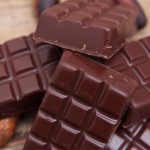 Montezuma, the King of the Aztecs when Hernando Corte”s and his conquistadors first encountered them, so believed in chocolate as an aphrodisiac that he reportedly drank fifty large cups of chocolate beverage each day. If this is true, then the lusty Montezuma must have imbibed about five cups of chocolate every waking hour, a quantity that surely prevented him from doing anything with his kingly phallus except relieve his burgeoning bladder. The word chocolate derives from the Nahuatl language spoken in southern Mexico and Central America by Montezuma and his subjects: their name for an unsweetened beverage made from cocoa beans was xocolatl, meaning bitter water, this word was adopted by Spanish as chocolate, which was then borrowed by English at the beginning of the seventeenth century. Perhaps surprisingly, the word cocoa, the name of the bean from which chocolate is made, is not related to the word chocolate: like chocolate, however, cocoa does derive from a Nahuatl word: cacahuatl, meaning beans of the cocoa tree. In what was perhaps their only act of moderation, the Spanish conquiistadors took only half of the word cacahuatl—the caca part—when they returned to Spain with bags and bags of the tasty beans. In the mid sixteenth century English adopted this Spanish name, but spelt it cacao, a form it retained until the beginning of the eighteenth century when its vowels shifted around and it became cocoa. Unfortunately this new spelling led to great confusion, because people inevitably mixed up cocoa with the unrelated coco, which appears in coconut, and with the unrelated coca, the name of a shrub whose leaves yield cocaine.
Montezuma, the King of the Aztecs when Hernando Corte”s and his conquistadors first encountered them, so believed in chocolate as an aphrodisiac that he reportedly drank fifty large cups of chocolate beverage each day. If this is true, then the lusty Montezuma must have imbibed about five cups of chocolate every waking hour, a quantity that surely prevented him from doing anything with his kingly phallus except relieve his burgeoning bladder. The word chocolate derives from the Nahuatl language spoken in southern Mexico and Central America by Montezuma and his subjects: their name for an unsweetened beverage made from cocoa beans was xocolatl, meaning bitter water, this word was adopted by Spanish as chocolate, which was then borrowed by English at the beginning of the seventeenth century. Perhaps surprisingly, the word cocoa, the name of the bean from which chocolate is made, is not related to the word chocolate: like chocolate, however, cocoa does derive from a Nahuatl word: cacahuatl, meaning beans of the cocoa tree. In what was perhaps their only act of moderation, the Spanish conquiistadors took only half of the word cacahuatl—the caca part—when they returned to Spain with bags and bags of the tasty beans. In the mid sixteenth century English adopted this Spanish name, but spelt it cacao, a form it retained until the beginning of the eighteenth century when its vowels shifted around and it became cocoa. Unfortunately this new spelling led to great confusion, because people inevitably mixed up cocoa with the unrelated coco, which appears in coconut, and with the unrelated coca, the name of a shrub whose leaves yield cocaine.
The comestible substance which is created through the grinding of cocoa beans, surpasses in richness to its precursor, has a dark brown hue, and can be procured in a saccharine or unsaccharine state.
Cocoa beans are a raw material that can be processed to create various products. The beans have three main parts, which are the nibs, germ, and shells. These parts can be separated and processed in different ways to produce different cocoa-based products.
When it comes to dipping food items in chocolate, a specific type of chocolate called couverture chocolate is needed. Even with couverture chocolate, it can be difficult for amateurs to achieve the same results as commercial chocolate companies. However, it is still possible to make delicious candies at home using ingredients such as toffee, fudge, marzipan, fondant, nuts, and dried fruit for the centers.
